Metabolism and Glycolysis Notes
1/69
There's no tags or description
Looks like no tags are added yet.
Name | Mastery | Learn | Test | Matching | Spaced |
|---|
No study sessions yet.
70 Terms
What is metabolism?
The complete set of biochemical reactions within cells, essential for sustaining life by managing both energy generation and cellular synthesis.
What is the function of catabolic pathways?
They break down large, complex molecules (polysaccharides, proteins, lipids) into smaller, simpler ones
What are coupled reactions in metabolism?
Reactions that occur simultaneously to drive an overall energy-releasing process, often linking exergonic (release energy) and endergonic (require energy) reactions, storing energy in carriers like ATP and NADH.
What is the enzymatic role in metabolism?
they act as biological cataysts, lowering activation energy and speeding up reaction rates without altering overall reaction equilibrium
How does energy transfer link catabolism to anabolism?
By supplying chemical energy for anabolic processes like biosynthesis, active transport, motility, and reproduction.
What is the core principle of microbial metabolism?
All living cells need a continuous supply of energy for essential activites (movement, growth, reproduction, structure)
What are catabolic processes?
Degradative processes that release chemical energy (ATP, NADH, FADH2) and are generally oxidative.
What are anabolic processes?
Synthetic processes that use energy to construct complex macromolecules from simplier precursors.
How do microorganisms primarily use oxygen?
As the terminal electron acceptor in the electron transport chain (ETC)
What is aerobic respiration?
A process where oxygen is the final electron acceptor in the ETC, producing high ATP yields (glycolysis)
What are the main energy carrier molecules?
NADH, FADH2, and ATP
What is the function of NADH and FADH2?
They transport high-energy electrons from nutrient oxidation to the ETC
What is the role of ATP?
Acts as the direct usable energy currency of the cell
Why is NADH important?
It carries high-energy electrons to the ETC, allowing energy generation
What is the reduced form of NAD+?
NADH from gaining 2 electrons and 2 protons (H+)
What is FAD oxidized and reduced forms?
Oxidized= FAD Reduced= FADH2
How is FAD reduced?
by adding 2 electrons and 2 protons (H+)
What is the composition of ATP?
An adenine base, ribose sugar, and three phosphate groups.
How is ATP formed?
By ADP gaining a phosphate (Pi)
Name the 3 ways ATP yield energy?
By hydrolysis, substrate-level phosphorylation, and oxidative phosphorylation.
What is substrate-level phosphroylation?
Direct ATP (or GTP) formation by transferring a phosphate group from a high-energy substrate to ADP, without oxygen of the ETC
How is ATP renewed in cells?
By constantly being recycled from ADP + Pi using energy from nutrient catabolism
What are autotrophs?
Organisms that produce their own food using photosynthesis or chemosynthesis; they make their own food
What are heterotrophs?
Organisms that cannot produce their own food and rely on consuming other organisms or organic compounds for energy.
What are phototrophs?
Organisms that obtain energy from light through photosynthesis.
What are chemotrophs?
Organisms that obtain energy by the oxidation of inorganic or organic substances, often through chemosynthesis.
What are lithotrophs?
“Rock-eaters” that use reduced inorganic substances as electron donors to obtain energy
What are organotrophs?
Organisms that obtain electrons from organic compounds for energy
What is anaerobic respiration?
A type of respiration that occurs in the absence of oxygen, where organisms convert energy from food without using oxygen, often producing compounds like lactic acid or ethanol as byproducts; Produces LESS ATP
What is fermentation?
A metabolic process that converts sugar to acids, gases, or alcohol in the absence of oxygen, often associated with anaerobic respiration. ATP is made only by substrate-level phosphorylation, making it less efficient than aerobic respiration.
What is Proton Motive Force (PMF)?
An electrochemical gradient of protons (H+) across a membrane used by ATP synthase to make ATP.
List the 3 main pathways from glucose to pyruvate.
Embden-meyerhof pathway (Glycolysis), Entner-Doudoroff pathway, and Pentose phosphate pathway.
Where does glycolysis occur in the cell?
Cytoplasm
Is glycolysis aerobic or anaerobic?
Anaerobic, but its products can feed into aerobic respiration
How many phases are there in Glycolysis and what are they?
2 phases: the energy investment phase and the energy payoff phase.
Define the investment phase in glycolysis.
Consists of reactions 1-5; consumes 2 ATP
Define the pay-off phase in glycolysis.
Consists of reactions 6-10; produces 4 ATP total (Net 2 ATP) and 2 NADH
What is the Entner-Doudoroff pathway?
A pathway used by some Gram-negative bacteria; produces 1 ATP, 1 NADPH, and 1 NADH per glucose
What is the Pentose-Phosphate pathway also called?
Hexose Monophosphate (HMP) or Phosphogluconate pathway
Why is the Pentose-Phosphate pathway important?
It provides NADPH for anabolic reactions and ribose-5-phosphate for nucleotide synthesis.
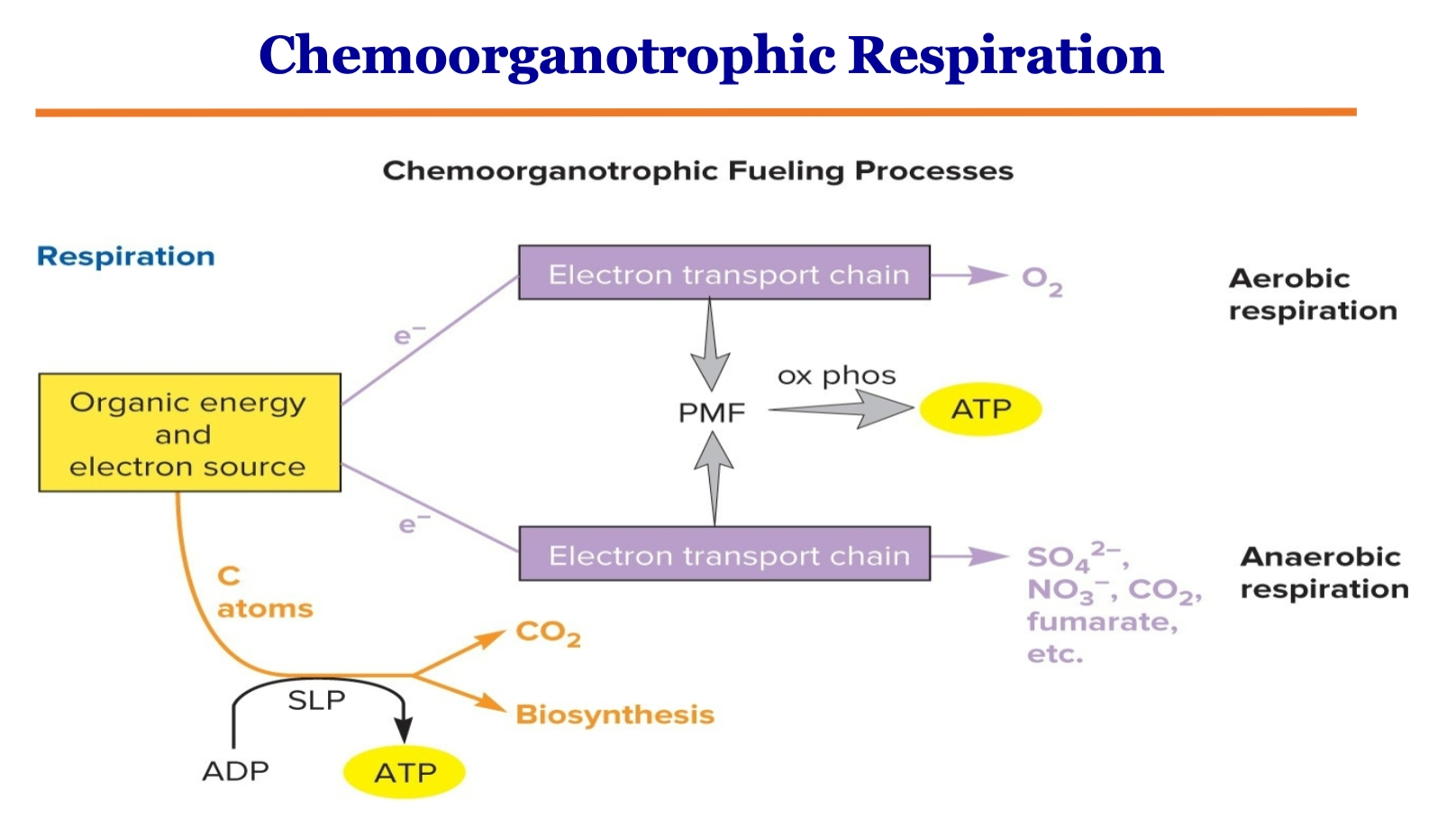
What does this image show? (study it)
It shows the chemoorganotrophic fueling process, indicating the products of aerobic and anaerobic respiration
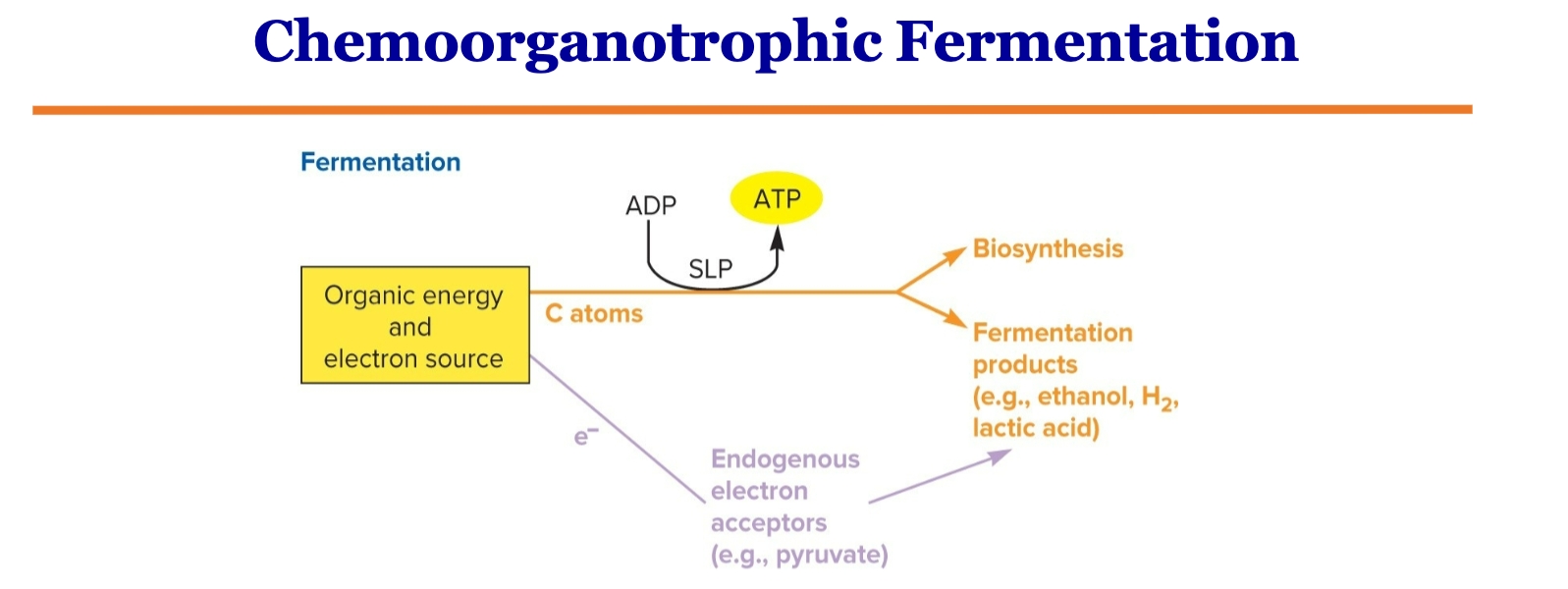
What does this image show? (study it)
It shows the chemoorganotrophic fermentation, indicating the fermentation products
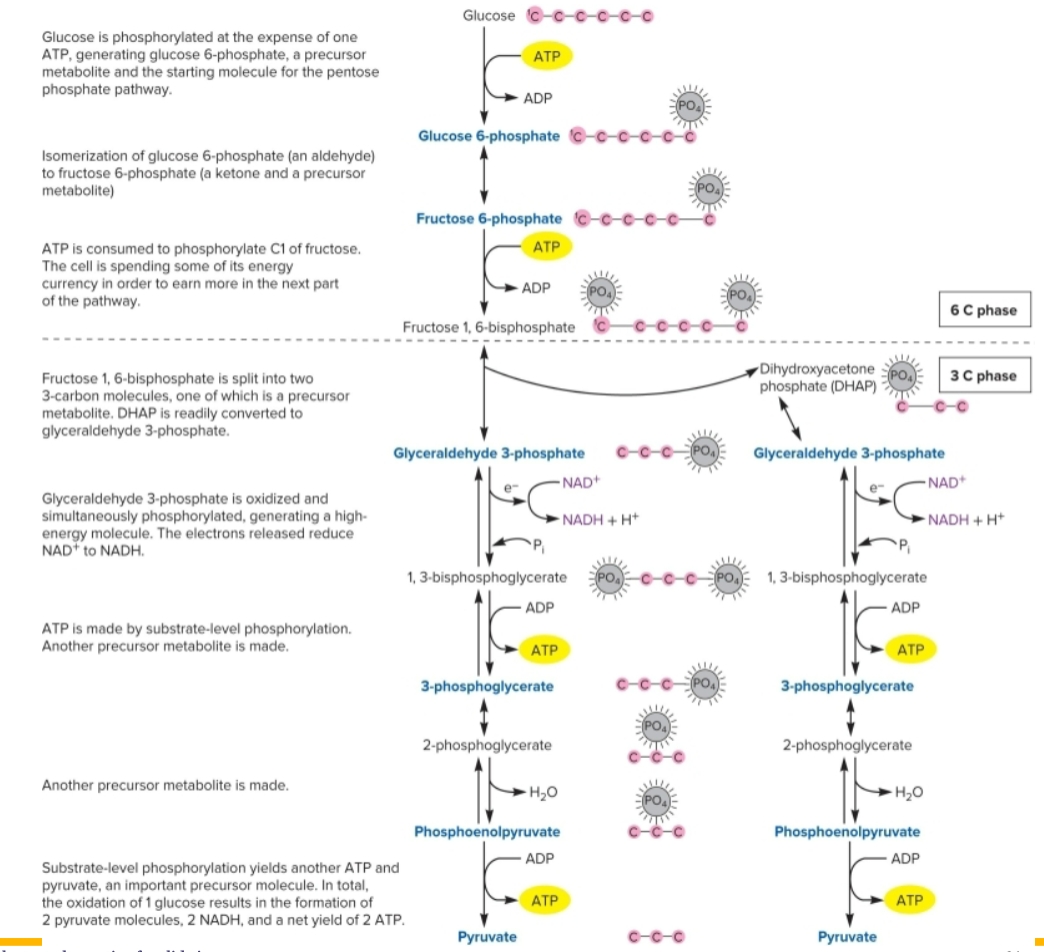
What does this image show? (study it)
It shows the process of Glycolysis
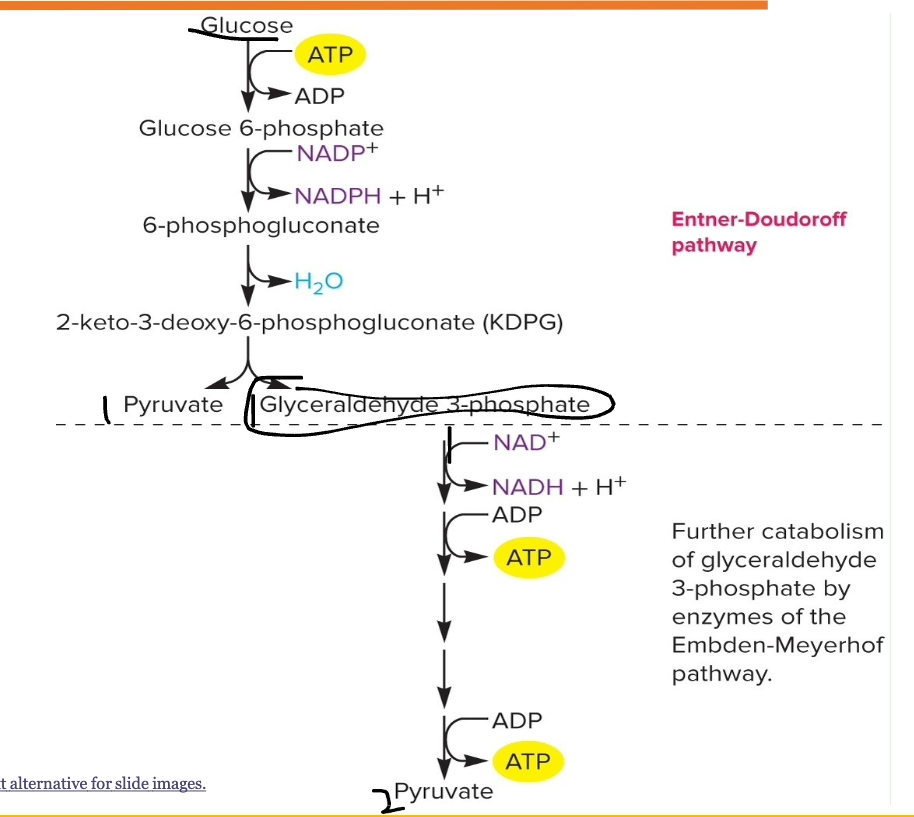
What does this image show? (study it)
It shows the process of the Entner-Doudoroff pathway
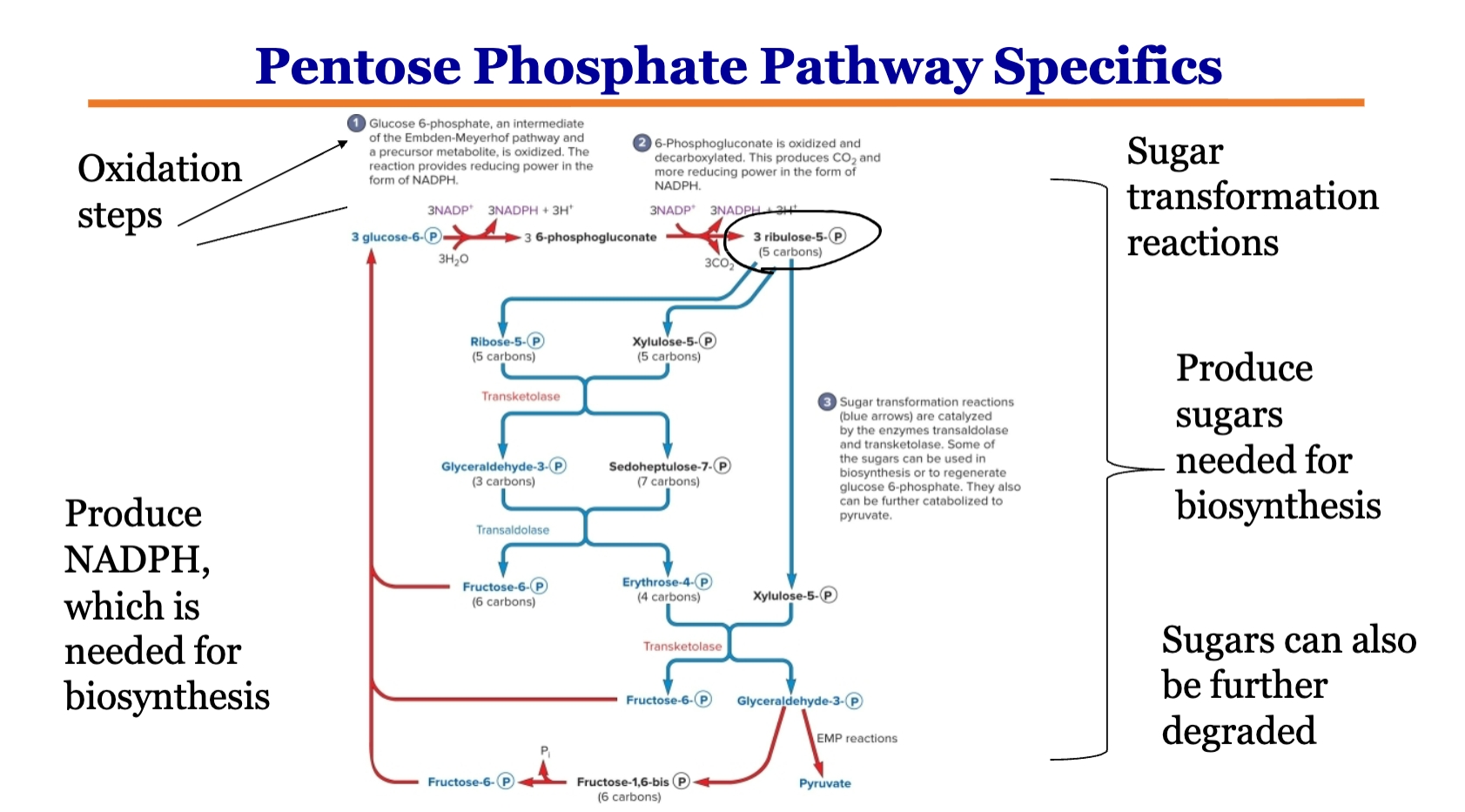
What does this image show? (study it)
It shows the pentose phosphate pathway
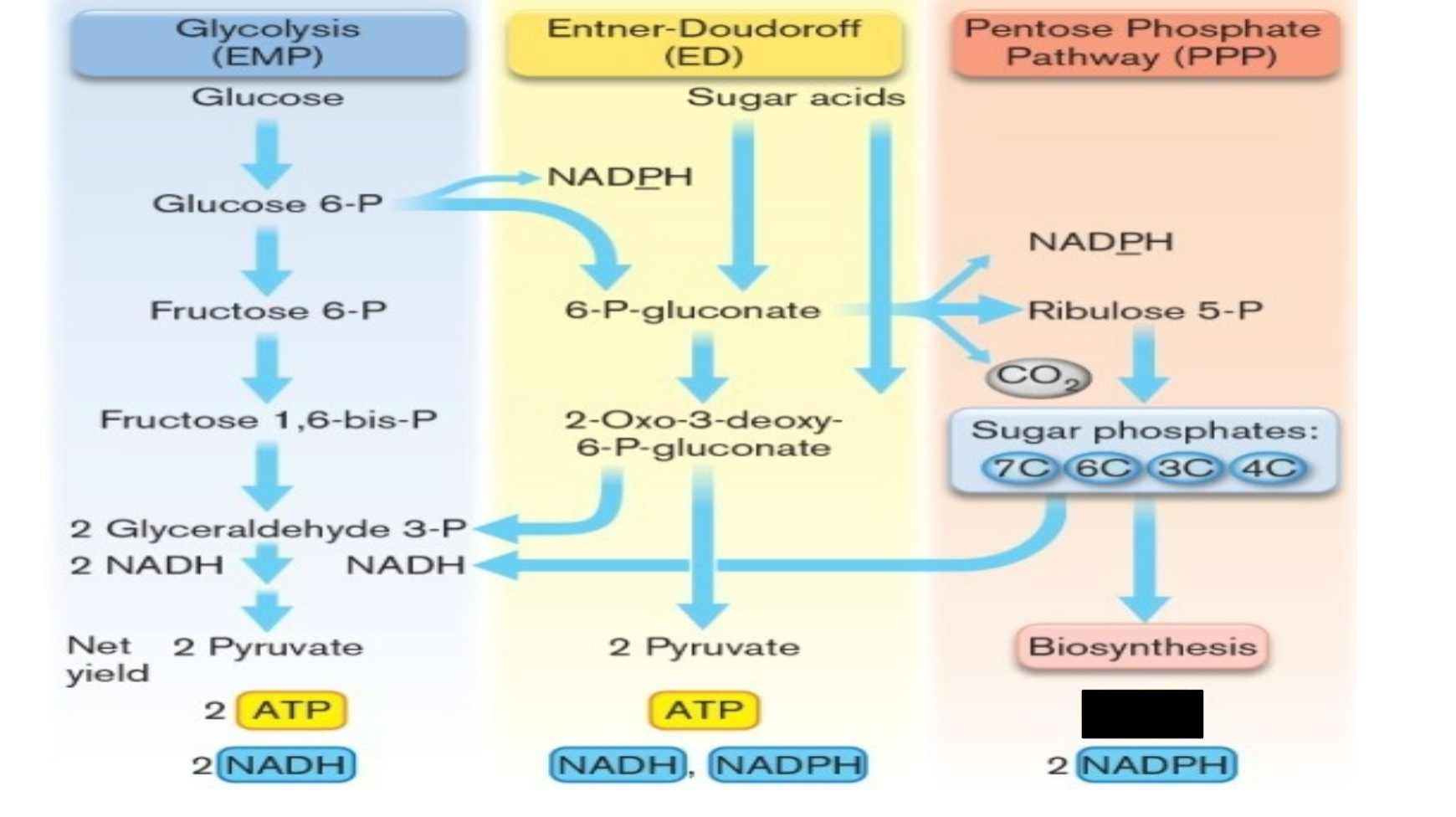
What does this image show? (study it)
It shows how all 3 pathways interlink
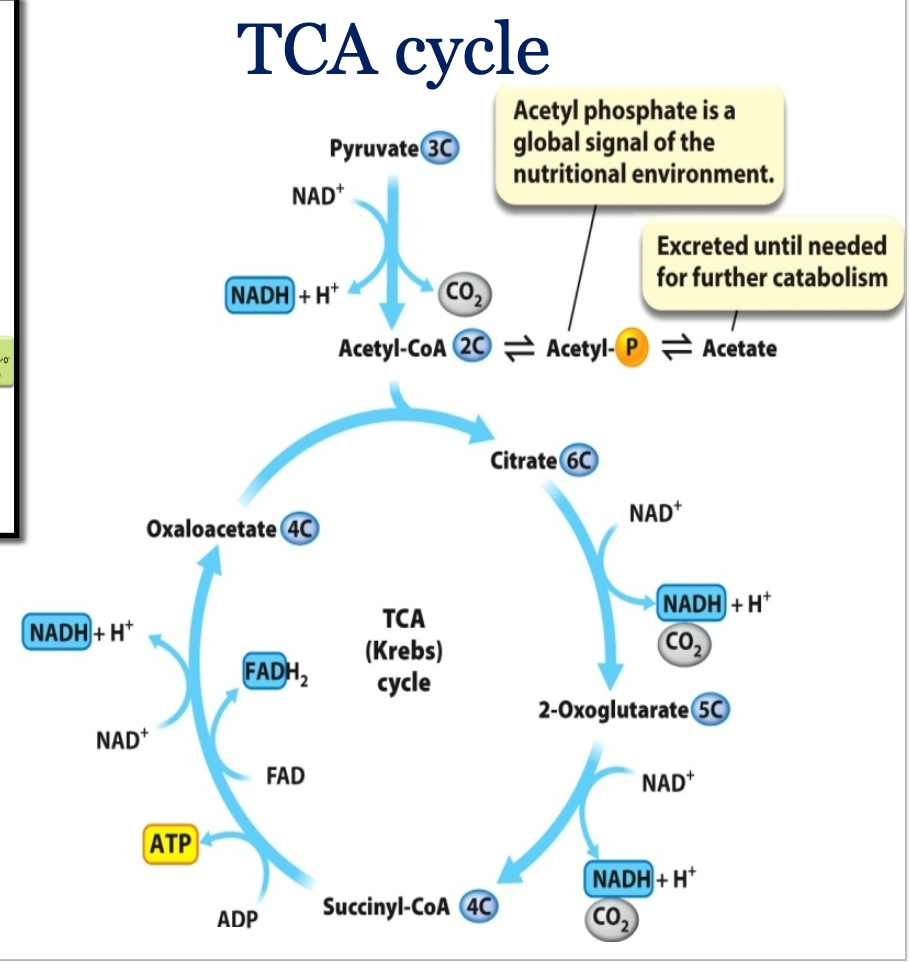
What does this image show? (study it)
It shows the TCA cycle (Krebs cycle)
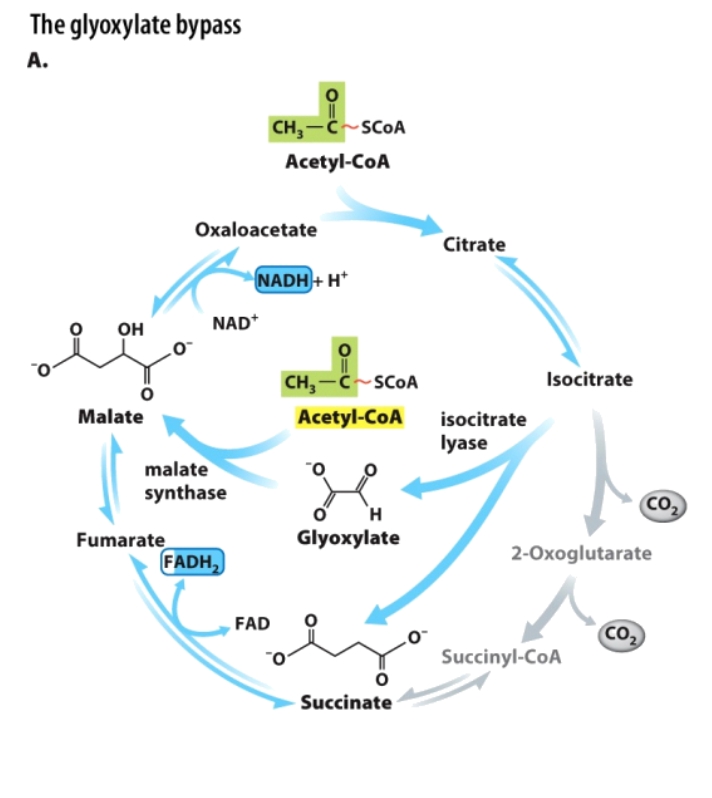
What does this image show? (study it)
It shows the glyoxylate bypass
Draw out the Gylcolysis Cycle. How many ATP, NADH, and pyruvate are produced?
2 ATP, 2 NADH, and 2 pyruvate
Draw out the TCA cycle. How many ATP, CO2, NADH, FADH2 is produced?
1 ATP, 3 NADH, 1 FADH2, and 2 CO2 are produced per cycle.
How many products PER GLUCOSE produce in the TCA cycle?
4 CO2, 6 NADH, 2 FADH2, 2 ATP (Mulitple the TCA cycle results by 2)
Draw the gyloxylate bypass. How many products are produced?
2 NADH, and 1 FADH2
What enzyme has to be produced from isocitrate in the TCA cycle to make Gyloxylate?
isocitrate lyase
What is the starting molecule and final products of gylcolysis?
Glucose —→ 2 pyruvate + 2 ATP (net) + 2 NADH
What are the regulatory/irreversible steps in glycolysis?
Hexokinase, PFK-1, and pyruvate kinase
Where does the TCA cycle occur in prokaryotes and eukaryotes?
Prokaryotes: cytoplasm
Eukaryotes: mitochondrial matrix
What enters the TCA cycle and combines with oxaloacetate?
Acetyl-CoA
What are the major products of one turn of the TCA cycle?
3 NADH, 1 FADH2, 1 GTP (ATP), 2 CO2
What key enzyme/regulation step is in the TCA cycle?
Isocitrate dehydrogenase
What organisms primarily use the Entner-Doudoroff pathway?
Many Gram-negative bacteria
What is the starting molecule and products of the Entner-Doudoroff pathway?
Glucose —→ 2 pyruvate + 1 ATP + 1 NADH + 1 NADPH
In the Entner-Doudoroff pathway, how does ATP yield compare to glycolysis?
lower, only 1 ATP is produced instead of 2 ATP
Why is the Entner-Doudoroff pathway useful?
It produces NADPH for biosynthesis and can metabolize sugars not handled by glycolysis
What is the main function of the Pentose-Phosphate pathway?
Generates NADPH for biosynthesis and ribose-5-phosphate for nucleotide synthesis.
Does the PPP make ATP?
No
What are the oxidative vs. non-oxidative phases products in the PPP?
Oxidative: NADPH + ribulose-5-phosphate
Non-oxidative: ribose-5-phosphate and glycoytic intermediates
What is the key enzyme of the oxidative PPP?
Glucose-6-phosphate dehydrogenase
What organisms use the glyoxylate bypass?
Bacteria, fungi, and plants
What is the key difference of the glyoxylate bypass compared to the TCA cycle?
It skips the decarboxylation steps (xketogluterate —> succinylCoA); conserves carbon
What are the two unique enzymes of the glyoxylate bypass?
Isocitrate lyase and malate synthase